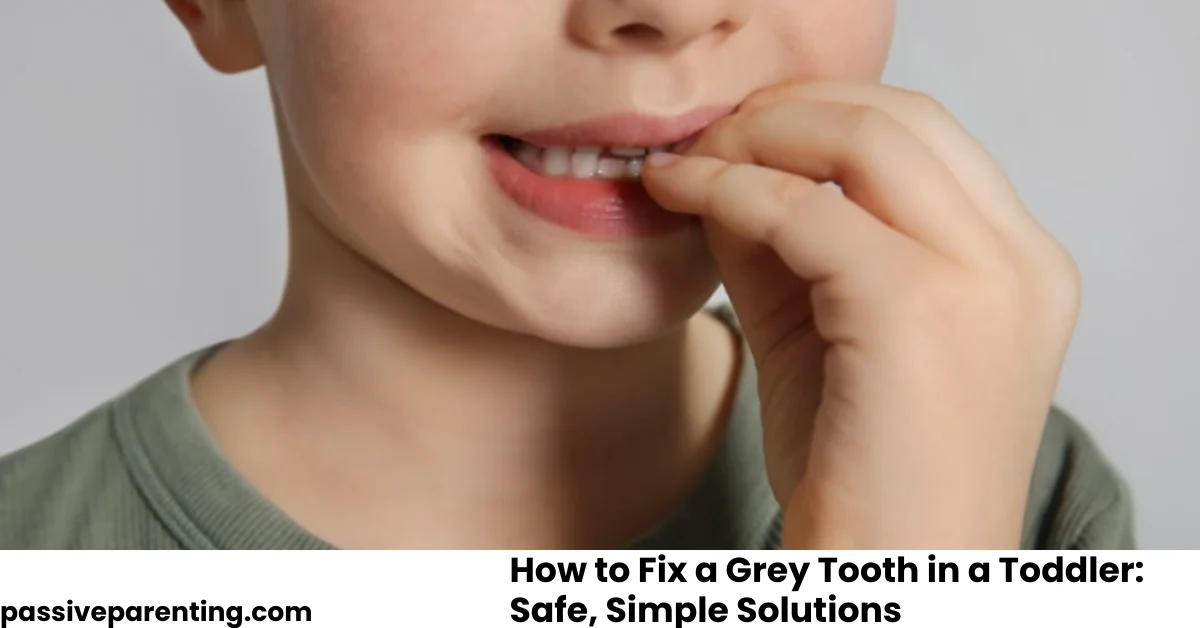Seeing a grey tooth in your toddler can be stressful for any parent. But with clear information, expert guidance, and the right approach, you can protect your child’s smile and address this common dental issue. This comprehensive guide explains what causes grey teeth in toddlers, how pediatric dentists treat them, what you can do at home, and when professional care is a must.
Why Does My Toddler Have a Grey Tooth?
A grey tooth in a toddler almost always points to an issue inside the tooth rather than a simple surface stain. The discoloration can range from pale grey to black, and understanding the difference is essential for effective treatment.
Common Causes of Grey Tooth in Toddlers
- Dental Trauma: Falls, bumps, or injuries during play can damage blood vessels inside baby teeth, leading to internal bleeding. The tooth turns grey—sometimes weeks after the injury—during healing or if the pulp dies.
- Tooth Decay: Untreated cavities can spread deep into the tooth, causing grey or black discoloration. This may signal significant damage and increased risk for infections.
- Medication Effects: Medications like tetracycline, taken during pregnancy or infancy, can cause intrinsic grey stains on developing teeth.
- Genetics and Enamel Issues: Thin enamel or conditions like enamel hypoplasia, where the outer tooth layer develops poorly, can make teeth appear grey or yellowish.
- Illness or Jaundice: Rarely, systemic health issues—like childhood jaundice or metabolic conditions—can change tooth color.
- Poor Oral Hygiene: Plaque build-up or poor tooth brushing invites discoloration and increases decay risk.
When to Worry About Grey Tooth in Children
While a grey tooth might simply be a sign of past injury, it could also mean nerve death, infection, or progressive decay. Warning signs to look for:
- Pain or sensitivity in the tooth or gums
- Swelling, redness, or bleeding
- A bump or abscess near the affected tooth
- Persistent bad breath not related to food
- Difficulty eating or changes in speech
If you notice these symptoms alongside a grey tooth, seek pediatric dental care immediately.
How to Fix a Grey Tooth in a Toddler: Step-by-Step Guide
Treating a grey tooth always begins with a professional evaluation, as the cause determines the best solution. Here’s a breakdown of options recommended by pediatric dentists:
1. Book a Pediatric Dental Exam
Early evaluation is the key. The dentist will inspect the tooth for damage, infection, pulp vitality, and overall oral health. X-rays may be needed to see root and nerve status.
2. Professional Dental Cleaning
If the grey color is due to surface stains, plaque, or mild enamel bruising (not deep injury), a gentle dental cleaning may restore normal color. At-home whitening products should never be used on toddlers.
3. Monitoring and “Wait & See” Approach
If the tooth shows mild grey discoloration after trauma but the pulp remains healthy, many dentists recommend simply monitoring. Studies show more than half of grey baby teeth lighten up over weeks to months as blood vessels heal—just like a bruise. The dentist will recheck regularly to ensure no complications arise.
4. Pulp Therapy (Baby Root Canal)
If the pulp (tooth nerve) is partially damaged or infected, procedures like pulpotomy (removing part of the pulp) or pulpectomy (entire pulp removal and filling) can save the tooth. These “baby root canals” are routine in pediatric dentistry and help prevent infection, pain, or premature tooth loss.
5. Dental Restoration: Fillings, Crowns, or Veneers
For visible front teeth or molars, restoration may involve a filling for cavities, a crown for broken or deeply damaged teeth, or a resin covering. The goal is to bring back a natural look while maintaining function.
6. Tooth Extraction
If the grey tooth is dead, abscessed, or threatens oral health, extraction may be required. Dentists will always prioritize saving the tooth for speech, nutrition, and jaw development unless removal is truly necessary.
At-Home Care and Prevention
While some discolorations require dental care, there’s a lot parents can do for prevention and overall oral health:
- Brush Twice a Day: Use a tiny smear of fluoride toothpaste and gently clean all tooth surfaces.
- Avoid Sugary Drinks & Bedtime Bottles: Milk, juice, and sweet drinks at bedtime increase decay risk and invite bacteria.
- Start Dental Visits Early: Schedule the first dental checkup by age 1 or within 6 months of the first tooth.
- Monitor for Trauma: If your toddler takes a tumble, watch the tooth for color changes over the next few weeks.
- Maintain Healthy Diet: Nutrients strengthen enamel and support healing.
Remember: Never use whitening products, abrasive toothpaste, or home “remedies” on grey baby teeth without professional advice.
Grey Tooth Recovery: What To Expect
Most grey (or gray) baby teeth heal with time or basic treatment. Pediatric dentists track progress using follow-up exams. In about half of cases involving mild trauma, baby teeth return to nearly normal color as blood flow improves. Severe discoloration, however, signals permanent pulp damage and may need intervention.
Dentists emphasize that prompt, gentle care and monitoring offer the best chance for recovery, preventing further complications and supporting your toddler’s overall health.
FAQ: Toddler Grey Tooth Treatment
Conclusion
A grey tooth in your toddler deserves attention but isn’t always a cause for alarm. Recognizing causes, seeking a timely dental exam, and following expert recommendations are the best ways to ensure lasting oral health. With professional help and informed home care, most children’s smiles recover beautifully—and parents gain peace of mind every step of the way.




